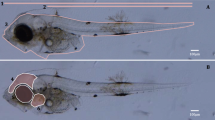Abstract
Acute and chronic toxicity tests with selenite-selenium (selenite-Se) were conducted onDaphnia pulex. The 48-hr static LC50 was 3.87 mg/L selenite-Se. The sublethal effects of 0.2, 0.4, 0.6, and 0.8 mg/L selenite-Se on the survival, growth, and reproduction ofD. pulex were monitored for 28 days, and the results were analyzed statistically by brood. Appreciable mortality occurred only at 0.8 mg/L Se. Growth, as measured by body length, was depressed at the highest concentration during the preadult instars and was slightly stimulated during the later adult instars. Number of live young per brood was depressed at 0.4, 0.6, and 0.8 mg/L Se during the early broods and apparently was stimulated in later broods. Reproductive dysfunction (i.e., dead young, deteriorated eggs, and abortions) was significant only at higher concentrations in the early broods. Results of the chronic study based on the brood method of analysis indicated safe concentrations between 0.2 and 0.4 mg/L selenite (Se).
Similar content being viewed by others
References
Adams, W. J., and H. E. Johnson: Selenium; A hazard assessment and a water quality criterion. In D. R. Branson and K. L. Dickson (eds.): Aquatic toxicology and hazard assessment, STP 737, p. 124. Philadelphia, PA: American Society for Testing and Materials (1981).
American Public Health Association: Standard methods for the examination of water and wastewater. 14 ed. Washington, DC: American Public Health Association (1976).
Barr, A. J., J. H. Goodnight, J. P. Sall, and J. T. Helwig: A user's guide to SAS 76. Raleigh, NC: SAS Institute Inc. (1976).
Brandlova, J., Z. Brandl, and C. H. Fernando: The Cladocera of Ontario with remarks on some species and distribution. Can. J. Zool.50, 1373 (1972).
Bringmann, G., and R. Kuhn: Vergleichende wassertoxikologische Untersuchungen an Bakterien, Algen un Kleinkrebsen. Gesund. Ing.80, 115 (1959).
Buikema, A. L., Jr.: Some effects of light on the biology of the cladoceran,Daphnia pulex, Ph.D. dissertation. Lawrence, KS: The University of Kansas (1970).
—: Some effects of light on the growth, molting, reproduction and survival of the cladoceran,Daphnia pulex. Hydrobiologia41, 391 (1973).
Buikema, A. L., Jr., and E. F. Benfield: Use of macroinvertebrate life history information in toxicity tests. J. Fish. Res. Board Can.36, 321 (1979).
Chau, Y. K., P. T. S. Wong, B. A. Silverberg, P. L. Luxon, and G. A. Bengert: Methylation of selenium in the aquatic environment. Science192, 1130 (1976).
Corbin, D. R., and W. M. Barnard: Atomic absorption spectrophotometric determination of arsenic and selenium in water by hydride generation. At Absorpt. Newsl.15, 116 (1976).
Doran, J. W., and M. Alexander: Microbial transformations of selenium. Appl. Environ. Microbiol.33, 31 (1977).
Fernandez, F. J.: Atomic absorption determination of gaseous hydrides utilizing sodium borohydride reduction. At. Absorpt. Newsl.12, 93 (1973).
Fleming, R. W., and M. Alexander: Dimethylselenide and dimethyltelluride formation by a strain ofPenicillum. Appl. Microbiol.24, 424 (1972).
Frost, D. V., and P. M. Lish: Selenium in biology. Annu. Rev. Pharmacol.15, 259 (1975).
Goettl, J. P., Jr., and P. H. Davies: Study of the effects of metallic ions on fish and aquatic organisms. Water Pollution Studies Job Progress Report. Colorado Dept. Nat. Resources, Div. Wildlife (1977).
Halter, M. T., W. J. Adams, and H. E. Johnson: Selenium toxicity toDaphnia magna, Hyallela azteca, and the fathead minnow in hard water. Bull. Environ. Contam. Toxicol.24, 102 (1980).
Helwig, J. T., ed: SAS supplemental library user's guide. Raleigh, NC: SAS Institute Inc. (1977).
Lee, D. R., and A. L. Buikema, Jr.: Molt-related sensitivity ofDaphnia pulex in toxicity testing. J. Fish. Res. Board Can.36, 1129 (1979).
Lindstrom, K., and W. Rodhe: Selenium as a micronutrient for the dinoflagellatePeridinium cinctum fa.westii. Mitt. Internat. Verein. Limnol.21, 168 (1978).
National Academy of Sciences: Selenium. Medical and Biologic Effects of Environmental Pollutants Series. Washington, DC: NAS (1976).
Pillay, K. K. S., C. C. Thomas, Jr. and J. W. Kaminski: Neutron activation analysis of the selenium content of fossil fuels. Nucl. Appl. Technol.7, 478 (1969).
Poston, H. A., G. F. Combs, Jr. and L. Leibozitz: Vitamin E and selenium interrelations in the diet of Atlantic salmon (Salmo salar): Gross, histological, and biochemical deficiency signs. J. Nutr.106, 892 (1976).
Schultz, T. W., S. R. Freeman, and J. N. Dumont: Uptake, depuration, and distribution of selenium inDaphnia and its effects on survival and ultrastructure. Arch. Environ. Contam. Toxicol.9, 23 (1980).
U.S. Environmental Protection Agency: Methods for chemical analysis of water and wastes. Cincinnati, OH: Environmental Monitoring and Support Laboratory, EPA-600/4-79-020 (1979).
—: Ambient water quality criteria for selenium. Washington, DC: Criteria and Standards Division, EPA 440/5-80-070, NTIS No. PB81-117814 (1980).
Author information
Authors and Affiliations
Rights and permissions
About this article
Cite this article
Reading, J.T., Buikema, A.L. Chronic effects of selenite-selenium onDaphnia pulex . Arch. Environ. Contam. Toxicol. 12, 399–404 (1983). https://doi.org/10.1007/BF01057582
Received:
Revised:
Issue Date:
DOI: https://doi.org/10.1007/BF01057582




